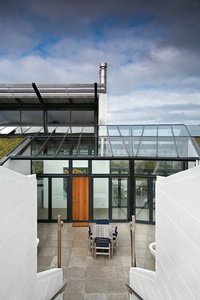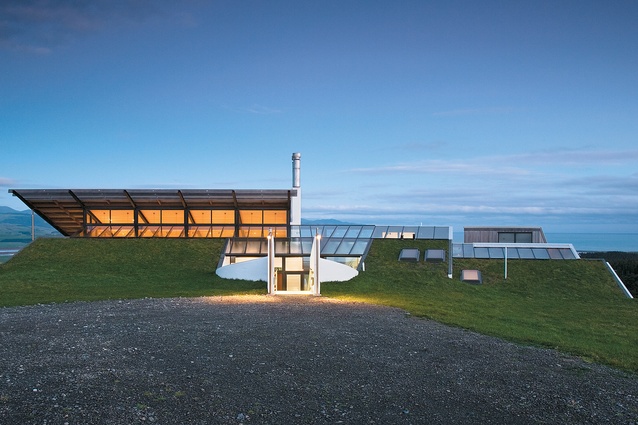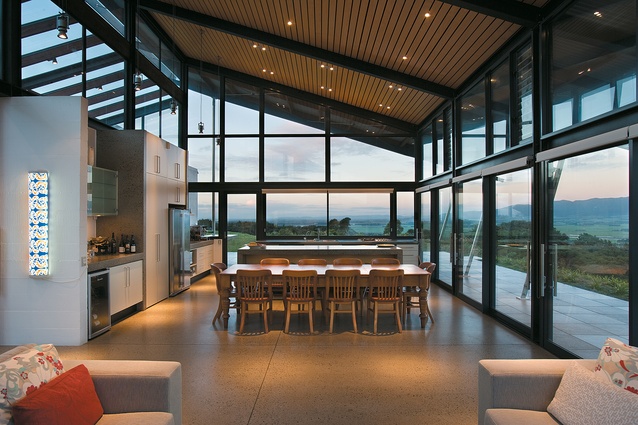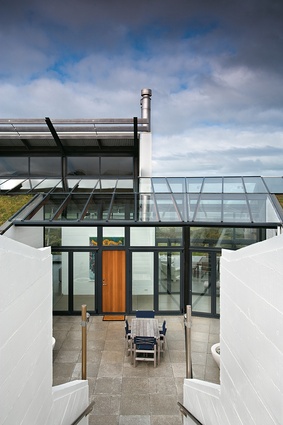Houses Revisited: Still on top
Look back at a house in wild Wairarapa that reprises the adventure and ambition of Gordon Moller’s early career.
In the Wairarapa, one of the roads less travelled, far away from Martinborough’s grapes and Greytown’s gentility, is the Western Lake Road. It runs south from Featherston towards the sea, tucked between the western edge of Lake Wairarapa and the foothills of the Rimutakas. On one of these hills, Pouanui Ridge, Moller Architects has designed a weekend home for two brothers and their partners – one couple based in Wellington and the other in London.
The ridge rises dramatically above the plain and the site sits forward hovering above the lake and facing south to Cape Palliser and the Tasman Sea. The climate here is far from benign; the southerlies start in Antarctica, building momentum up the Southern Alps before whistling through the gap at the bottom of the North Island. Frequently changing, often harsh and always dramatic, the weather demands an architecture robust enough to stand up for itself. Gordon Moller and his team delivered with a collection of boxes that braves the microclimate and engages with the view – a house that opens to the world but also provides protection from it.
The first temptation on a site as exposed as this would be to turn one’s back on the ferocity of the weather and face north for the sun. Fortunately, the architect has resisted this temptation and the house courageously squares off against all the weather has to offer. The house retreats into the earth at the northern side of the site, eschewing the easy option of direct sun, and throws itself to the edge of the ridge. Roofs tilt up, covered with earth and grass which merges, seamlessly – and unexpectedly – in the same plane with roof glazing bringing light into the house below.

There are two axes to the house. The primary one, running roughly east to west and following the contours of the site, runs along either side of the entry court, and is accessed at both east and west ends. This axis creates the spine of the house, and is completely glazed on ribs that float high above.
At a crick in this back, a north-south axis intersects joining two courts. This axis starts at the top of the site at a stair that descends between the flipping roofs, terminating in an outdoor court providing shelter from the southerly. A lone cedar door in a wall of glass opens into the gallery. Opposite, another door leads to the southern court with an outdoor fireplace and spectacular views over Lake Ferry.
These axes divide the house into very different quadrants. To the northeast is the underground world of the home theatre and the office, bunkered and enclosed. The living area to the southeast stands tall and erect, commanding the broadest view. To the southwest are the two bedrooms of the owners, boxes scattered on the hillside. In the northwest is the guest room and the service rooms, buried and concealed in the earth.
The living area is disarming. In plan it appears insufficient for the scale of the house; in reality its vertical scale determines its power and prominence. This is a house for tall people: 3 metre x 2.5 metre sliding doors reveal a simple room with a luxury of height rarely seen. This room is a tall glass box with a monopitch roof floating 6 metres above, creating a clerestory to the north and protection to the south. The simple steel structure takes an ordinary arrangement of spaces and elevates them to the elegant through the generosity of volume. Restraint edges out audacity giving the room a quiet composure.

The wall to the hallway is off-the-boxing concrete painted white. To the south and the view is a group of eight sliding glass doors. Between are the living, dining and kitchen. The kitchen bench, like the floor, is polished concrete; the ceiling is battened in European Ash. The room has a sense of uncomplicated lightness despite the agglomeration of glass and steel that holds it together.
There are many views to be had, from Cape Palliser to the south, the Aorangi Range to the east and the Wairarapa to the northeast – all seen best from the terrace off the kitchen, a simple plane of concrete pavers. The terrace can also be accessed from the office, which admits light through high glazing to the home theatre.
The owners’ bedrooms are mirror image rooms that enjoy the same generous height as the living area. The rooms are two boxes that break free from the geometry of the house to create their own worlds, each with its own focus and individual views. In the bathrooms, the wall over the vanity breaks out, letting in light and an intimate view of the world beyond. Across the generous hallway is the guest bedroom and bath and the utility rooms. The bedrooms are carpeted and the walls painted.

Elsewhere, underfloor heating keeps the polished concrete comfortable and the spine of the house is strengthened through the rough-cast concrete wall poured in situ. The white painted concrete is textured from the roughsawn boxing with exquisite detailing where it meets doors and windows.
At first glance this appears to be an excellently maintained house from the 1960s or perhaps the ’70s. The structure, construction and detailing call to mind the ambition and adventure of the architecture of that period. Closer inspection reveals it to be more sophisticated and mature, less urgent and eager than those pioneering houses. Much of the architecture of that time had something to prove. This house suffers no such burden and is more confident and assured, producing an architecture of robust repose.
Courage defines this house. Architect and client have boldly resisted the easy route, anchoring the house to the earth, projecting it out towards the wild and wilful Wairarapa coast. Extensive use of glass could have diluted the power of the house and risked making it cold and unfriendly. But here it is the house’s salvation, drawing in light and opening up views. This is a house of cards and sticks, delicately assembled in a rugged fashion.
Click here to see more Houses Revisited.
















